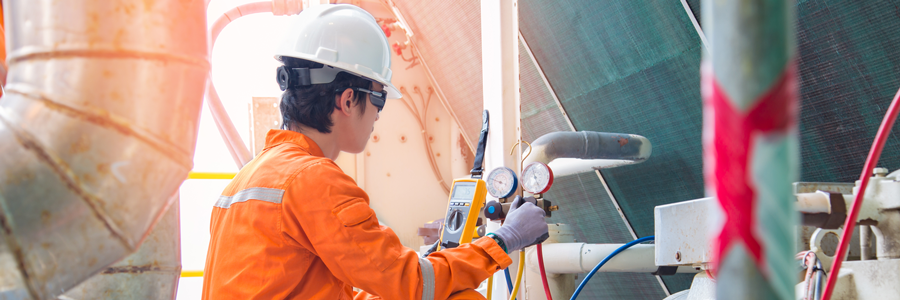
For Centuries, scientists, inventors and outside-the-box thinkers have been trying to manipulate substances in order to alter the temperature of the indoors!
1756: Dr. William Cullen, a Scottish physician and professor, published “Of the Cold Produced by Evaporating Fluids and of Some Other Means of Producing Cold.”
1758: Benjamin Franklin and John Hadley, a professor at Cambridge University, experimented with the cooling effect of certain rapidly evaporating liquids.
1824: Michael Faraday, a self-declared philosopher, discovered that heat would be absorbed by pressurizing gas, like ammonia, into a liquid.
1840: Physician and inventor, Dr. John Gorrie, wanted to reverse the effects of yellow fever and “the evils of high temperatures.”1 As a result, he developed a machine that created ice through compression. Gorrie was granted the first U.S. Patent for mechanical refrigeration in 1851.1
1876: German engineer Carl von Linden patented the process of liquefying gas setting the stage for the modern air conditioner.2
The Evolution of Refrigerant
Modern air conditioning appears to be an evolutionary invention that was built upon a series of successful (and not so successful) concepts. It took 80 years from Dr. Gorrie’s primitive ice-maker method for a group of individuals to develop a safe, non-toxic and easily-produced substance that could be used to provide indoor cooling for the masses.
In 1928, Thomas Midgley, Albert Henne and Robert McNary created chlorofluorocarbon (CFC) refrigerants. The compounds produced were “the world's first non-flammable refrigerating fluids, greatly improving the safety of air conditioners.”3 One of the compounds developed was R-22, a hydrochlorofluorocarbon (HCFC) that became a standard refrigerant utilized in residential air conditioners for decades to come.
But as they say, history has a way of repeating itself. Decades later, scientists would discover that chlorine, a component of CFC and HCFC refrigerants, is damaging to the ozone layer. As a result, R22, the standard residential air conditioner refrigerant, was included in the 1987 Montreal Protocol list of substances that were to be phased out of production over time for new air conditioners and heat pumps.
The Montreal Protocol
According to the U.S. State Department, “The Montreal Protocol, finalized in 1987, is a global agreement to protect the stratospheric ozone layer by phasing out the production and consumption of ozone-depleting substances (ODS).” With 197 countries in agreement, it was the first United Nations treaty to achieve universal ratification.4
Under the Protocol, which was amended four times since 1988, total United States HCFC production and consumption should be phased out by 2030.
The Economics of Change
Because R-22 was so widely utilized, it couldn’t be eliminated overnight without severe economic impacts to the private and public sectors. As a result, the Montreal Protocol and amendments allowed for a step-by-step phase out. This phased program provides homeowners the option of switching to chlorine-free refrigerants when they see the need to replace their current air conditioner or heat pump.
Although the agreement was ultimately signed in 1988, the HVAC industry had to prepare for the mandated changes. Companies had to develop alternate refrigerant technologies, engineer new designs to accommodate substance characteristics, realign manufacturing to accommodate changes, and re-train dealers and technicians on the updates. This would take some time, but R-410A refrigerant, a hydrofluorocarbon compound (HFC), was soon considered to be the most common alternative to R-22.
Out with R-22, In with R-410A
The Environmental Protection Agency (EPA) is responsible for implementing the R-22 refrigerant phase out for the United States. By January 1, 2010, there was a ban on the production and import of R-22.5 As a result, manufacturers of heat pump and air conditioning equipment redesigned their systems to accommodate R-410A, a chlorine-free refrigerant compared to R-22. The refrigerant would soon replace R-22 in the new HVAC equipment.
EPA regulations require a ban on the production and import of R-22 refrigerant by January 1, 2020. After 2020, any air conditioning or heat pump system using R-22 that requires servicing will have to depend on potentially expensive R-22 stockpiles or reclaimed refrigerant. The new ban on R-22 won’t affect homeowners that want to continue to utilize their functioning R-22 air conditioning systems. However, in the event that that equipment needs to be charged with refrigerant, there will be difficulties.6
Is R-410A Here to Stay?
As stated, modern air conditioning has been an evolutionary invention that was built upon a series of successful (and not so successful) concepts. If history has taught us anything, it’s that progress will continue. Scientific discoveries, technological advancements, and even environmental policies and politics will continue to have an effect on the HVAC industry.
Next Generation Refrigerants
Because of the global warming potential of many HFC refrigerants, the latest amendment to the Montreal Protocol, the Kigali Amendment, has proposed to phase-down the use of refrigerants such as R-410A. The phase down is expected to begin sometime in the 2020’s. The leading replacement for R-410A refrigerant is a pure, single component refrigerant called R-32, which has one-third the global warming potential of R‑410A. Some products with this next generation refrigerant have already been introduced in the United States. Due to some properties of these lower global warming refrigerants, codes and standards are being updated before their mainstream use, which is expected in the early 2020’s.
In the meantime, homeowners replacing their aging air conditioning and heat pump systems with new R-410A equipment will know that they are purchasing a chlorine-free option, as well as potentially increasing the energy-efficiency level of the air conditioner or heat pump for their homes.

1, 3 Department of Energy. History of Air Conditioning. 20 July 2015. https://www.energy.gov/articles/history-air-conditioning. 3 April 2017.
2 Weisand, Dr. John. "Defining Cryogenics." Cold Facts (2010). https://www.cryogenicsociety.org/resources/defining_cryogenics/joule-thomson_effect/.
4 U.S. Department of State. The Montreal Protocol on Substances that Deplete the Ozone Layer. Washington D.C., n.d. https://www.state.gov/e/oes/eqt/chemicalpollution/83007.htm.
5 Environmental Protection Agency. Federal Register. 28 October 2014. https://www.federalregister.gov/documents/2014/10/28/2014-25374/protection-of-stratospheric-ozone-adjustments-to-the-allowance-system-for-controlling-hcfc. 3 April 2017.
6 R22 and Halon Critical Use Phase-out. n.d. http://www.epa.ie/air/airenforcement/ozone/r22andhaloncriticalusephase-out/. 3 April 2017.